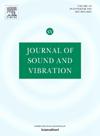Stability analysis of shimmy under the consideration of tire pavement contact mechanics behavior
IF 4.3
2区 工程技术
Q1 ACOUSTICS
引用次数: 0
Abstract
The analysis and research on shimmy stability are generally based on established tire parameters and flat and rigid pavement models. Modern aircraft taxiing requires verification and comprehensive evaluation in combination with landing gear shimmy physical tests and special scenario flight tests. The size of tire imprints affects the dynamic characteristics of tires, and empirical formulas do not take into account the contour shape and contact surface state of tires. At the same time, the study and analysis of shimmy often overlook the influence of pavement curvature. Based on this, in order to study the mutual influence of tire contact deformation and pavement curvature on shimmy stability, this paper takes the landing gear system as the research object, combines shimmy analysis methods, line contact models, and point contact models, and establishes a shimmy analysis model that considers the elastic-plastic deformation of tire pavement contact. The accuracy of the theoretical model is verified through imprint tests, and deviation coefficients are introduced to analyze the differences in shimmy response results between traditional models and contact models. The results show that the new tire deformation theory can better fit the test data and consider the effects of tire configuration, grooves, and contact surface curvature; The tire imprints obtained by different algorithms have certain differences, and tire imprints have a significant impact on the stability of shimmy; The critical damping deviation required for anti shimmy of the landing gear system decreases with the increase of the ratio of flywheel to tire radius, and can reach a deviation of over 20% for both point contact and line contact models; Ensuring that the tire has the same imprint length and the same compression amount will result in deviations in the evaluation of the stability analysis of the shimmy, and the results of the shimmy test bench need to be corrected.
求助全文
约1分钟内获得全文
求助全文
来源期刊

Journal of Sound and Vibration
工程技术-工程:机械
CiteScore
9.10
自引率
10.60%
发文量
551
审稿时长
69 days
期刊介绍:
The Journal of Sound and Vibration (JSV) is an independent journal devoted to the prompt publication of original papers, both theoretical and experimental, that provide new information on any aspect of sound or vibration. There is an emphasis on fundamental work that has potential for practical application.
JSV was founded and operates on the premise that the subject of sound and vibration requires a journal that publishes papers of a high technical standard across the various subdisciplines, thus facilitating awareness of techniques and discoveries in one area that may be applicable in others.
 求助内容:
求助内容: 应助结果提醒方式:
应助结果提醒方式:


